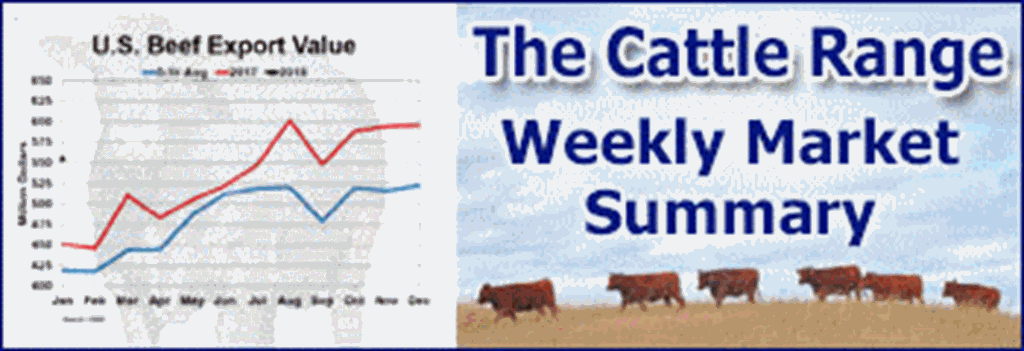August ‘World Agricultural Supply and Demand Estimates’
LIVESTOCK, POULTRY, AND DAIRY:
The forecast for 2023 red meat and poultry production is reduced from last month on lowered beef, pork, and broiler forecasts. Beef production is lowered on lower steer and heifer slaughter and lighter dressed weights although cow slaughter is increased. Pork production reflects lighter dressed weights although slaughter is raised slightly. Broiler production is reduced on lower expected eggs set and continued relatively low hatchability. Turkey production is raised on slaughter data and hatchery data. Egg production is lower as hatchery data has indicated lower-than-previously-expected flock productivity and slower additions of pullets to the laying flock.
For 2024, the red meat and poultry production forecast is raised on higher beef and turkey production which more than offsets lower broiler production. Beef production is raised, reflecting higher expected placements in late 2023 and early 2024. These cattle are expected to be slaughtered during 2024. Cow slaughter is also raised for the first part of 2024. Turkey production is raised slightly for early 2024. Pork production is unchanged from last month. Growth in broiler production is slowed with lower prices expected to reduce producer margins. The slower pace of egg production growth in 2023 is expected to carry into early 2024.
Beef imports for 2023 are adjusted to reflect recent trade data but no change is made to the forecasts for second-half 2023 or 2024. The beef export forecast is unchanged for 2023. Exports are raised for 2024 from last month on higher expected supplies of beef. Pork imports and exports are adjusted to reflect June data, but no change is made to the forecasts for the remainder of 2023 or 2024. Broiler exports are reduced for 2023 and 2024 on lower expected production. Turkey exports are raised on lower expected prices.
Cattle price forecasts for 2023 and 2024 are raised on continued firm packer demand. The 2023 hog price forecast is raised on current price strength, but no changes are made to 2024. The broiler price forecasts for 2023 and 2024 are lowered. Turkey price forecasts for 2023 and 2024 are lowered on current prices and expectations of continued weak demand.
COARSE GRAINS:
This month’s 2023/24 U.S. corn outlook is for reduced supplies, lower domestic use, smaller exports, and tighter ending stocks. Projected beginning stocks for 2023/24 are 55 million bushels higher based on a lower use forecast for 2022/23, reflecting reductions in corn used for exports, glucose and dextrose, and starch. Corn production for 2023/24 is forecast at 15.1 billion bushels, down 209 million from the July projection and if realized, would be the second highest on record behind 2016/17. The season’s first survey-based corn yield forecast, at 175.1 bushels per acre, is 2.4 bushels lower than last month’s projection. Today’s Crop Production report indicates that among the major producing States, yields are forecast above a year ago in Indiana, Iowa, Nebraska, Ohio, and South Dakota. Yields in Illinois, Minnesota, and Missouri are forecast below a year ago.
Total U.S. corn use for 2023/24 is cut 95 million bushels to 14.4 billion. Feed and residual use is lowered 25 million bushels based on a smaller crop. Corn used for glucose and dextrose and starch is projected lower based on observed use during 2022/23. Exports for 2023/24 are cut 50 million bushels to 2.1 billion. With supply declining more than use, ending stocks are lowered 60 million bushels to 2.2 billion. The season-average corn price received by producers is raised 10 cents to $4.90 per bushel.
This month’s 2023/24 foreign coarse grain outlook is for lower production, reduced trade, and smaller ending stocks relative to last month. Foreign corn production is down, with cuts to the EU, China, and Russia partially offset by increases for Ukraine and Canada. EU corn production is sharply lower with reductions to both area and yield. The largest declines are for Hungary, Romania, Germany, and Italy. China corn production is reduced as excessive wetness in key producing provinces in Northeast China and on the North China Plain reduces yield prospects. Corn production for Ukraine is higher with increases to both area and yield as timely rainfall and a lack of extreme heat during July boost yield expectations. Russia corn production is reduced based on lower area. Foreign barley production is cut on declines for the EU, Canada, and Russia.
Major global coarse grain trade changes for 2023/24 include lower corn exports for the United States and the EU. Ukraine corn exports are unchanged with the expiration of the Black Sea Grain Initiative. Corn imports are raised for Canada and Zimbabwe but lowered for Egypt, Vietnam, and Algeria. Barley exports are cut for Canada and the EU. Barley imports are raised for the EU but lowered for China and Iran. Foreign corn ending stocks are down 1.6 million tons to 255.1 million, reflecting declines for China, Zambia, and Russia that are partly offset by increases for Ukraine and South Africa.
WHEAT:
The outlook for 2023/24 U.S. wheat this month is for decreased supplies, slightly lower domestic use, reduced exports, and higher stocks. Supplies are reduced as wheat production is forecast at 1,734 million bushels, down 5 million from last month as lower Other Spring and White wheat production is partially offset by increases for Hard Red Winter (HRW), Soft Red Winter, and Durum. The all wheat yield is 45.8 bushels per acre, down 0.3 bushels from last month. Domestic use is lowered 3 million bushels, all on food use, based on the NASS Flour Millings Products report, issued August 1. Wheat exports are reduced 25 million bushels to 700 million, on the weak sales and shipment pace to date for HRW, where all the reduction is made. Projected 2023/24 ending stocks are raised 23 million bushels to 615 million but remain well below the 5-year average of 846 million. The 2023/24 season-average farm price is unchanged at $7.50 per bushel.
The global wheat outlook for 2023/24 is for reduced supplies, lower consumption, decreased trade, and lower stocks. Supplies are projected to decline 4.3 million tons to 1,061.7 million as reduced production for the EU, China, and Canada is only partially offset by increases for Ukraine and Kazakhstan. The EU is lowered 3.0 million tons to 135.0 million, primarily due to reductions for Spain, Lithuania, and Romania. China is reduced 3.0 million tons to 137.0 million, based on the National Bureau of Statistics summer grain production forecast. Canada is decreased 2.0 million tons to 33.0 million on worsening drought conditions in the Prairie Provinces. Ukraine is increased 3.5 million tons to 21.0 million on higher area harvested and yields with the forecast yield the second highest on record. Kazakhstan is raised 1.0 million tons to 15.0 million on higher area reported by Kazakhstan’s Bureau of National Statistics.
Global consumption is reduced 3.4 million tons to 796.1 million, mainly on lower feed and residual use for the EU and reduced food, seed, and industrial use by China. World trade is decreased 2.2 million tons to 209.4 million on reduced exports by Canada and the United States. Despite higher production, Ukraine’s exports are unchanged at 10.5 million tons with the expiration of the Black Sea Grain Initiative. Projected 2023/24 global ending stocks are lowered 0.9 million tons to 265.6 million, the lowest since 2015/16.












